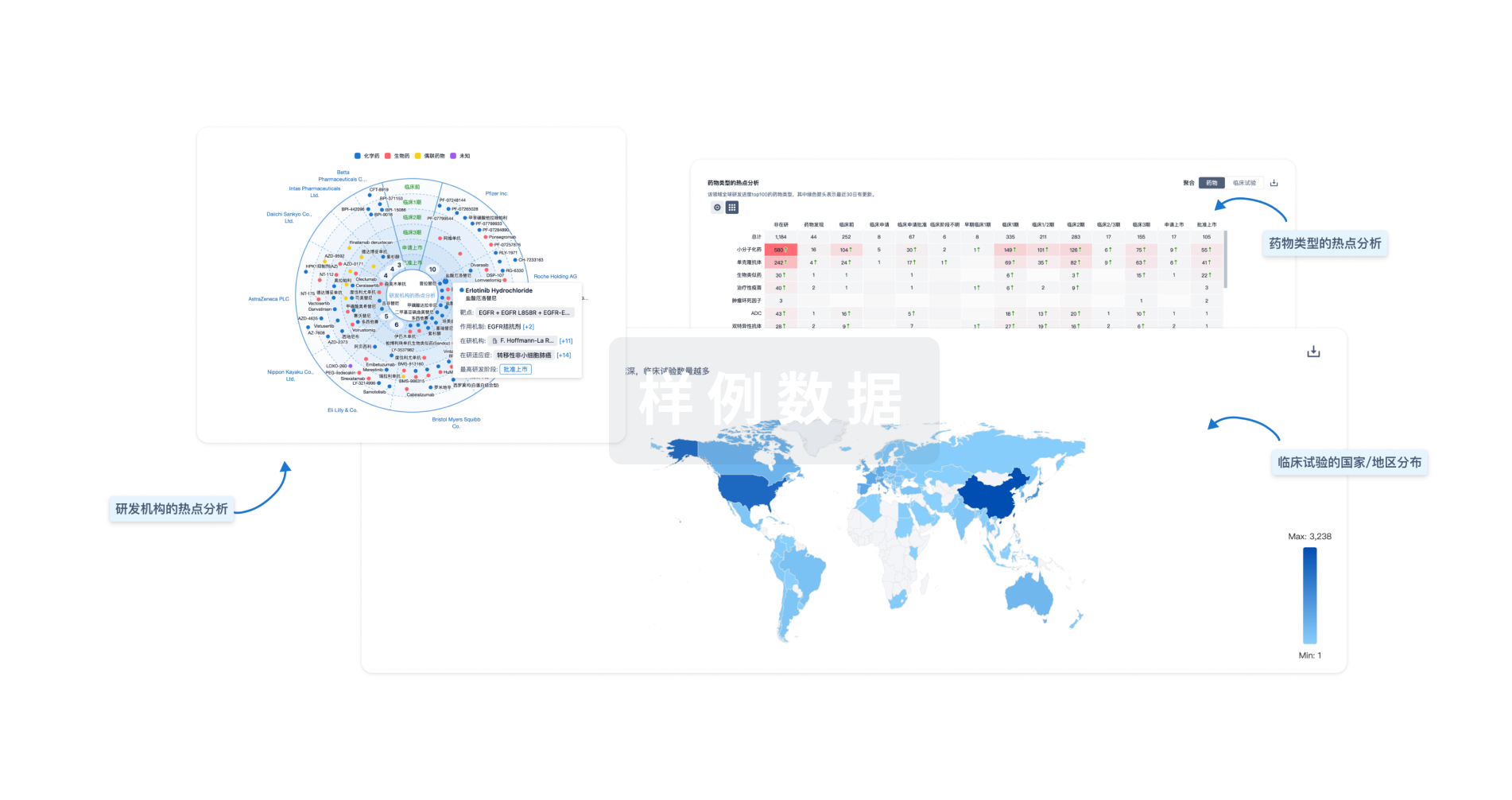预约演示
更新于:2025-05-07
Renal interstitial fibrosis
肾间质纤维化
更新于:2025-05-07
基本信息
别名 RENAL INTERSTITIAL FIBROSIS、Renal interstitial fibrosis、Renal interstitial fibrosis (disorder) + [2] |
简介 The accumulation of collagen and related extracellular matrix (ECM) molecules in the interstitium of the kidney. The interstitium is expanded by the presence of collagen that stain blue on trichrome. Tubules are not back to back, but rather separated by fibrosis and can be atrophic. [PMID:22449945] |
关联
1
项与 肾间质纤维化 相关的药物CN116514779
专利挖掘靶点- |
作用机制- |
在研机构 |
原研机构 |
非在研适应症- |
最高研发阶段药物发现 |
首次获批国家/地区- |
首次获批日期1800-01-20 |
100 项与 肾间质纤维化 相关的临床结果
登录后查看更多信息
100 项与 肾间质纤维化 相关的转化医学
登录后查看更多信息
0 项与 肾间质纤维化 相关的专利(医药)
登录后查看更多信息
1,157
项与 肾间质纤维化 相关的文献(医药)2025-12-31·Renal Failure
Noninvasive grading of renal interstitial fibrosis and prediction of annual renal function loss in chronic kidney disease: the optimal solution of seven MR diffusion models
Article
作者: Chen, Wei ; Yin, Ting ; Cai, Lingli ; Darwish, Omar ; Han, Min ; Liao, Zhouyan ; Li, Zhen ; Zhou, Kailun ; Xu, Chuou ; Liang, Ping ; Yuan, Guanjie
2025-12-31·Renal Failure
Delta corticomedullary apparent diffusion coefficient on MRI as a biomarker for prognosis in IgA nephropathy
Article
作者: Jiang, Ling ; Zeng, Ming ; Duan, Suyan ; Zhang, Chengning ; Yuan, Yanggang ; Pan, Ying ; Huang, Zhimin ; Mao, Huijuan ; Zhang, Yudong ; Zhang, Bo ; Lu, Fang ; Sun, Bin ; Xing, Changying ; Wang, Zitao ; Qian, Li
2025-12-31·Renal Failure
Factors associated with chronic calcineurin inhibitor nephrotoxicity in children with minimal-change disease
Article
作者: Yang, Shicong ; Chen, Lizhi ; Jiang, Xiaoyun ; Jin, Bei ; Lin, Aihua ; Pei, Yuxin ; Mo, Ying ; Lu, Ziji ; Cheng, Cheng ; Yue, Zhihui
16
项与 肾间质纤维化 相关的新闻(医药)2025-04-16
IDF 2025微专辑扫描二维码可查看更多内容编者按:过去数十年间,全球糖尿病负担持续加重,已成为慢性肾病(CKD)和终末期肾病(ESKD)的主要病因。在过去30年中,全球因2型糖尿病(T2D)导致的CKD发病率增加了74%,而T2D所致的ESKD比例也在全球范围内不断上升。这些数据表明,糖尿病导致的CKD和ESKD在全球范围内已成为日益严重的健康问题。刚刚召开的世界糖尿病联盟2025世界糖尿病大会(IDF 2025),聚焦糖尿病合并CKD相关管理策略进展,本刊特邀西北大学附属西安国际医学中心医院姬秋和教授进行点评,为临床实践提供深入洞见。糖尿病合并CKD管理:从微量白蛋白尿到ESKD的整体视角全球范围内,代谢性疾病、心血管和肾脏负担沉重,其中CKD全球患病率约11%,且在亚洲负担尤为突出[1]。T2D患者至少半数合并CKD,CKD显著增加T2D患者心血管疾病和过早死亡风险[2]。针对这一严峻局势,芬兰赫尔辛基大学医院Per-Henrik Groop教授在IDF 2025专题探讨会上,基于从微量蛋白尿到ESKD的整体视角深入探讨了T2D合并CKD患者临床管理[3]。识别早期CKD患者至关重要。CKD的发生及其严重程度,均可有效预测T2D患者的长期预后和死亡风险,是T2D最容易识别、最佳的风险“marker”(标志物)。在美国国家健康与营养检查调查(NHANES)中,10年累积标准化死亡率在有T2D但无CKD的患者中为4.1%,而在同时患有两种疾病的患者中高达47%[4]。目前CKD临床诊断主要基于白蛋白尿[尿白蛋白肌酐比值(UACR)≥30mg/g]和/或肾功能降低[估算肾小球滤过率(eGFR)<60 ml/min/1.73m2],同时排除其他原发性肾脏损伤[5]。其中,白蛋白尿是CKD的早期标志,其出现往往早于eGFR下降,对于预测心肾疾病结局具有重要意义[6]。一项瑞典队列研究[7](n=266,305,中位随访5.6年)显示,2型糖尿病患者伴UACR在3-30mg/mmol时,心衰住院风险已较UACR<3mg/mmol显著增加;且UACR水平越高,心衰住院风险越高。然而,全球范围内,T2D患者的UACR筛查率和知晓率均不理想,很多患者未能及时诊断,导致病情延误。充分理解CKD发生发展的危险因素和关键驱动因素。糖尿病、高血压、吸烟、肥胖是常见危险因素,代谢失调和血流动力学异常协同导致肾小球囊内压增加,整体肾单位的水钠及葡萄糖滤过和重吸收均出现异常;炎症和纤维化通路导致肾单位的单核细胞、巨噬细胞、成纤维细胞浸润和增加,出现足细胞异常、基底膜增厚、细胞外基质重塑等改变,且代谢紊乱、血流动力学、炎症/纤维化等因素相互作用,共同促进CKD发生发展。其中,炎症和纤维化是疾病进展的关键驱动因素,由盐皮质激素受体(MR)过度活化介导,引发一系列反应,导致肾小球硬化、肾间质纤维化和肾小管损伤,进而影响肾脏功能[8]。降低白蛋白尿,显著改善T2D合并CKD患者的预后。蛋白尿不仅是早期诊断的标志物,也是影响疾病进展的关键因素——既与肾脏疾病进展相关,也与心血管疾病风险显著相关。荟萃分析结果和指南均明确提出,UACR减少30%可显著降低CKD进展风险[9]。通过降低蛋白尿水平,可以显著减缓肾功能下降速度,降低心血管事件风险,改善患者长期预后。FIDELITY研究[8]进一步证实这一点,非奈利酮可显著降低T2DM合并CKD患者的心血管和肾脏复合结局风险,其中CKD进展风险降低23%、心血管复合终点风险降低14%、新发心衰风险降低32%、ESKD风险降低20%;同时研究显示,使用非奈利酮4个月UACR即显著降低32%,其降低UACR作用在改善肾脏和心血管结局中起到了重要的介导作用。1型糖尿病(T1D)合并CKD的风险管理。尽管T1DM患者数量相对较少,但T1D合并CKD与早期死亡风险升高紧密相关,其高发病率和严重预后不容忽视。白蛋白尿在T1D和T2D发生CKD的病理生理机制中的作用有诸多相似,因此UACR可作为T1D中CKD进展的重要生物标志物,在疾病进展和心血管风险预测方面发挥重要作用。对于T1D合并CKD患者,有效的治疗和管理策略同样至关重要。目前正在开展的FINE-ONE临床研究,旨在评估非奈利酮对成人T1D合并CKD患者的疗效和安全性,其结果令人翘首以盼。Groop教授还指出,包括ADA指南在内的多项指南均推荐T2DM相关CKD早期,应采取多机制联合治疗降低心肾事件风险,包括血糖、血压和血脂管理,以及使用具有心血管和肾脏保护的药物,其中非奈利酮作为核心治疗支柱予A类推荐。糖尿病合并CKD患者新视角:非奈利酮展现持续疗效IDF 2025上还公布了一项印度观察性研究[10],聚焦非奈利酮改善糖尿病合并CKD患者白蛋白尿的疗效及停药后的持久影响。研究纳入100例糖尿病合并CKD患者,平均年龄53岁,其中64例有微量白蛋白尿,36例有大量白蛋白尿。所有患者均接受非奈利酮20 mg每日一次治疗,为期1年。治疗期间,每3个月评估尿白蛋白水平和UACR,对达到正常白蛋白尿状态的患者停药后继续监测6个月。在整个研究期间,所有患者均接受了标准糖尿病治疗。结果显示,经过1年非奈利酮治疗,除12名无法继续随访的患者外,其余所有患者的白蛋白尿均显著减少。其中,79%患者达到正常白蛋白尿状态,其余21%患者白蛋白尿自基线降幅超过50%。更为重要的是,在停药后6个月随访中,86%患者保持了正常白蛋白尿状态。研究提示,非奈利酮显著减少白蛋白尿同时,可能具有记忆/遗留效应,即在停止干预后仍可持续产生有益影响;后续可开展大规模研究探索非奈利酮的长期益处及潜在机制。专家点评姬秋和 教授西北大学附属西安国际医学中心医院糖尿病合并CKD管理是一个复杂且长期的过程,虽然目前已取得一定进展,但仍面临诸多挑战。最近贾伟平院士团队发布的研究成果显示[11],中国糖尿病患者中CKD患病率为32.6%,其中白蛋白尿患病率为30.8%, eGFR降低的患病率为5.5%。估计中国约有3,900万(1/3)糖尿病患者合并CKD。这些数据凸显了中国糖尿病患者中CKD流行的紧迫性。需制定有效的防控策略,遏制其流行趋势。应认识到,UACR不仅是早期发现CKD的重要监测指标,还在评估疾病进展、心血管风险以及治疗效果方面发挥着重要作用。UACR的变化可以作为评估治疗效果的指标。近年来心肾获益的药物不断涌现,其中非奈利酮作为新型非甾体MAR, 具有直接抗炎抗纤维化作用,为T2D合并CKD管理提供了新的治疗武器,得到多项指南的A类推荐。在FIDELITY研究中,非奈利酮在治疗初期即显著降低T2D合并CKD患者的UACR,并且疗效持续;减缓eGFR下降的同时,延缓CKD进展及降低心血管事件风险。糖尿病合并CKD管理任重道远,需要我们持续关注前沿研究成果,不断优化临床治疗策略。非奈利酮等新型药物的出现带来了新希望,在实际应用中,需结合患者具体情况,充分发挥这些药物的优势,共同应对糖尿病合并CKD这一全球性健康挑战。专家简介姬秋和 教授西北大学附属西安国际医学中心医院西安国际医学中心内分泌代谢病院 院长、主任医师、教授中华医学会糖尿病学分会副主任委员中国内分泌代谢病专科联盟副理事长中国肥胖联盟常务理事曾中国医师学会内分泌代谢医师分会第一至第五届委员会常务委员曾任陕西省医学会糖尿病分会第四届委员会主任委员《中华糖尿病杂志》、 《国际内分泌代谢杂志》副总编辑《中华内分泌代谢杂志》、《中国糖尿病杂志》、《中国临床药理学与治疗学杂志》 、《Diabetes/Metabolism Research and Reviews》等编委2017年首届国家名医高峰论坛“国之名医.优秀风范”参考文献(上下滑动可查看)1.Liyanage T, et al. BMJ Glob Health. 2022; 7(1): e007525.2.Thomas MC, et al. Nat Rey Dis Primers. 2015; 1: 15018.3.Per-Henrik Groop. CLINICAL MANAGEMENT OF DIABETIC NEPHROPATHY – FROM MICROALBUMINURIA TO ENDSTAGE RENAL DISEASE. Meet-the-Expert Session. Presented at the IDF World Diabetes Congress 2025.4.Afkarian Met al. J Am Soc Nephrol 2013:24:3025.Kidney Disease: lmproving Global Outcomes (KDIGO). Kidney Int Suppl. 2013; 3: 1-163.6.Afkarian M.Pediatr Nephrol 2015:30:65-747.Rosengren A et al. Diabetologia 2018:61:2300-98.Coresh J, et al. Lancet Diabetes Endocrinol. 2019; 7(2): 115-127.9.Agarwal R, et al. Eur Heart J. 2022; 43(6): 474-484.10.Sanjay Sud, et al. Albuminuria Reversal in Diabetic Nephropathy: Finerenone’s Lasting Impact. E- Poster: BA2025-138. Presented at the IDF World Diabetes Congress 2025.11.Weiping Jia, et al. Lancet Reg Health West Pac. 2025 11:55:101463.声明:本文仅供医疗卫生专业人士了解最新医药资讯参考使用,不代表本平台观点。该等信息不能以任何方式取代专业的医疗指导,也不应被视为诊疗建议,如果该信息被用于资讯以外的目的,本站及作者不承担相关责任。最新《国际糖尿病》读者专属微信交流群建好了,快快加入吧!扫描左边《国际糖尿病》小助手二维码(微信号:guojitnb),回复“国际糖尿病读者”,ta会尽快拉您入群滴!(来源:《国际糖尿病》编辑部)版权声明版权属《国际糖尿病》所有。欢迎个人转发分享。其他任何媒体、网站未经授权,禁止转载。
临床结果临床研究临床终止
2024-10-28
·药明康德
▎药明康德内容团队编辑
日前,Vera Therapeutics公布其在研药品atacicept用于治疗IgA肾病(IgAN)患者的2b期临床试验ORIGIN的最新数据。结果显示在96周的长期随访中,患者肾功能持久维持稳定,显示atacicept在改变IgAN患者疾病自然进程和预防肾功能衰竭方面的潜力。根据新闻稿,这是目前维持肾功能稳定时间最长的B细胞调节剂之一。行业媒体Fierce Biotech指出,该药物显著的持久疗效接近达成肾病“功能性治愈”的目标。试验详细结果公布于2024年美国肾脏学会(ASN)肾脏周会议,并同时在《美国肾脏学会杂志》发表。目前临床3期试验ORIGIN 3正在进行中,Vera预计在2025年第二季度公布该试验的顶线结果,并计划于年内向FDA提交生物制品许可申请(BLA)。
IgAN是一种严重的进行性自身免疫性肾病。在高达50%的患者中,IgAN会发展成终末期肾病(ESKD)或肾衰竭,将对患者的生活造成巨大的影响。IgAN是由具有免疫原性的半乳糖缺陷性IgA1(Gd-IgA1)的产生驱动的,它能够触发自身抗体导致致病性免疫复合物IgA的形成,而IgA沉积在肾小球中会引起炎症和进行性损伤。IgA肾病的进展会伴发肾小球硬化、肾间质纤维化、肾功能不全、蛋白尿和高血压。
ORIGIN是一项全球多中心、随机、双盲、安慰剂对照的临床2b期试验,旨在评估atacicept在116名IgAN患者中的安全性和有效性。这些患者在至少12周最大耐受剂量的肾素-血管紧张素-醛固酮系统抑制剂治疗下仍然存在蛋白尿,且病情进展风险较高。试验的主要终点为第24周尿蛋白与肌酐比值(UPCR)变化,关键次要终点为第36周UPCR变化。
分析显示,试验达到主要和关键次要终点。在第36周时,与安慰剂相比,atacicept组患者显示出统计学显著且具临床意义的蛋白尿减少和稳定的估计肾小球滤过率(eGFR)。此外,atacicept和安慰剂的安全性结果相当。
而这次所公布的96周长期数据显示,atacicept组患者显示出病理性Gd-IgA1水平减少达66%、75%患者血尿消失、蛋白尿减少52%,年化eGFR斜率为-0.6 mL/min/1.73 m²。值得注意的是,有研究表明,普通人群的年化eGFR斜率为-1 mL/min/1.73 m²。该药物的总体安全性良好,90%的参与者完成了atacicept治疗。
▲ORIGIN试验96周疗效结果(图片来源:参考资料[2])
Atacicept是一种重组融合蛋白,含有可溶性跨膜激活剂和钙调亲环素配体相互作用因子(TACI)受体,可以与B细胞活化因子(BAFF)和增殖诱导配体(APRIL)结合。这些细胞因子是肿瘤坏死因子家族的成员,可促进与某些自身免疫性疾病(包括IgAN和狼疮性肾炎)相关的B细胞存活和自身抗体产生。Vera公司认为该候选药物通过靶向B细胞和浆细胞以减少自身抗体,可能成为潜在“best-in-class”药物。Atacicept曾获得美国FDA授予突破性疗法认定,用以治疗IgAN患者。
目前Vera公司计划于2024年第四季度启动ORIGIN试验的延伸研究,以收集atacicept更长期的临床数据;并同时计划于2025年启动PIONEER研究,用以评估atacicept在更广泛的IgAN患者,和带有抗PLA2R和抗肾素抗体的足细胞病患者中的有效性和安全性。
▲Atacicept药物设计(图片来源:参考资料[2])
目前临床上获批用以治疗IgAN患者的药物包含阿斯利康(AstraZeneca)的SGLT2抑制剂Farxiga(达格列净)、诺华(Novartis)替代补体通路因子B抑制剂Fabhalta(iptacopan)、Calliditas Therapeutics的皮质类固醇免疫抑制剂Tarpeyo(budesonide,布地奈德),以及Travere Therapeutics的“first-in-class”内皮素/血管紧张素受体拮抗剂Filspari(sparsentan)等。
而目前处于临床3期阶段的IgAN药物管线则包含大冢制药(Otsuka Pharmaceutical)旗下的在研APRIL靶向单抗sibeprenlimab。上周所公布的3期临床试验VISIONARY积极结果显示,与安慰剂相比,sibeprenlimab在治疗9个月后显著且具有临床意义地降低了IgAN患者的24小时UPCR变化。大冢计划与FDA讨论试验结果,以推动sibeprenlimab潜在加速批准的监管申请。而诺华自Chinook
Therapeutics收购所获得的口服内皮素A受体拮抗剂atrasentan,以及抗APRIL单克隆抗体zigakibart目前也皆处于3期试验阶段。去年10月所公布的36周中期分析结果显示,atrasentan可显著降低患者的蛋白尿。诺华计划与美国FDA讨论此中期结果,以实现潜在加速批准的监管递交。罗氏(Roche)与Ionis Pharmaceuticals也共同合作开发IONIS-FB-LRx(RG6299)用以治疗IgAN。这是一款靶向补体因子B的反义寡核苷酸疗法,罗氏预计在2027年递交相关上市申请。
▲欲了解更多前沿技术在生物医药产业中的应用,请长按扫描上方二维码,即可访问“药明直播间”,观看相关话题的直播讨论与精彩回放
参考资料:
[1] Vera Therapeutics Announces 96-week eGFR Stabilization in ORIGIN
Phase 2b Study of Atacicept in IgAN in a Late-Breaking Oral Presentation at the
American Society of Nephrology Kidney Week 2024. Retrieved October 28, 2024 from https://ir.veratx.com/news-releases/news-release-details/vera-therapeutics-announces-96-week-egfr-stabilization-origin
[2] Corporate Presentation. Retrieved October 28, 2024 from https://ir.veratx.com/static-files/469e722f-5da8-4dad-9a54-e52ba68596f7
[3] Analysts hail Vera's kidney drug as potential 'functional cure' as
benefits persist to Week 96. Retrieved October 28, 2024 from https://www.fiercebiotech.com/biotech/analysts-hail-veras-kidney-drug-potential-functional-cure-benefits-persist-week-96
[4] Barratt J, Barbour S, Brenner R, Cooper K, Wei X, Eren N, Floege J, Jha V, Kim SG, Maes B, Phoon RKS, Singh H, Tesař V, Lafayette R; ORIGIN Phase 2b Investigators. Long-Term Results from an Open-Label Extension Study of Atacicept for the Treatment of IgA Nephropathy. J Am Soc Nephrol. 2024 Oct 26. doi: 10.1681/ASN.0000000541. Epub ahead of print. PMID: 39462308.
免责声明:药明康德内容团队专注介绍全球生物医药健康研究进展。本文仅作信息交流之目的,文中观点不代表药明康德立场,亦不代表药明康德支持或反对文中观点。本文也不是治疗方案推荐。如需获得治疗方案指导,请前往正规医院就诊。
版权说明:本文来自药明康德内容团队,欢迎个人转发至朋友圈,谢绝媒体或机构未经授权以任何形式转载至其他平台。转载授权请在「药明康德」微信公众号回复“转载”,获取转载须知。
分享,点赞,在看,聚焦全球生物医药健康创新
临床结果突破性疗法临床3期临床2期
2024-04-15
关注并星标CPHI制药在线 4月10日,Vertex Pharmaceuticals(福泰制药) 和Alpine Immune Sciences共同宣布,两家公司已达成最终协议:Vertex将以每股65美元的价格收购Alpine,总价约49亿美元现金。该交易获得了Vertex和Alpine董事会的一致批准,预计将于本季度晚些时候完成。 此次收购将为Vertex带来什么? Alpine公司成立于2015年,公司致力于Fc融合蛋白、细胞治疗、单克隆抗体等免疫疗法的开发。公司通过改善天然的IgSF或TNFSF / TNFRSF蛋白的活性,将它们转化为具有增强结合多个靶标能力的候选药物,并应用于癌症、自免和炎症性疾病的治疗。 Alpine核心产品povetacicept (ALPN-303) 是一种高效的B细胞活化因子(BAFF)和增殖诱导配体(APRIL)双拮抗剂。BAFF属于肿瘤坏死因子(TNF)配体超家族的一种细胞因子。APRIL也是一种TNF成员,研究发现自免疾病患者APRIL mRNA的表达水平明显高于正常人。 通过II期临床研究发现,povetacicept在 IgA肾病(IgAN)方面显示出了同类产品中最佳的潜在疗效,预计今年下半年将启动III期临床研究。 通过此次收购,Vertex将会切入IgA肾病领域,而这是一个巨大的尚未被满足的市场。 被巨头看中的金矿 免疫球蛋白A(IgA)肾病是全球最常见的原发性肾小球肾炎,也是一种严重的进行性自身免疫性肾病,是导致慢性肾病(CKD)和肾功能衰竭的主要病因。IgA肾病进展会伴发肾小球硬化、肾间质纤维化、蛋白尿和高血压等。其中50%的IgA肾病患者在30年内会进展为终末期肾病(ESRD)。ESRD的标准治疗是透析或肾移植,尚无针对性治疗药物,严重影响患者生活质量。 IgA肾病在东亚人群中的发病率最高。一项跨国研究的系统回顾表明,IgA肾病全球总体人口发病率至少为2.5/10万,并且发病人群呈现较大地域差异。2022年,美国IgA肾病患者人数在6.3万至27.3万不等,而中国患者人数最高突破290万。弗若斯特沙利文的报告预测,2030年全球IgA肾病患者总数或将达到1020万人(包括中国240万人)。全球IgA肾病治疗药物市场预计将从2020年的5.67亿美元增至2025年的11.96亿美元,复合年增长率达16.1%。 尽管患者群体规模庞大,但目前针对IgA肾病的获批药物仅两款,分别为云顶新耀/Calliditas的布地奈德迟释胶囊(耐赋康,TARPEYO)及TRAVERE公司的司帕生坦片(TRAVERE)。 因此,IgA肾病领域存在巨大的未满足需求,这也是药企重金入局的原因。 诺华等重金入局,IgA肾病在研新药蓄势待发 作为竞争格局较好的自免适应症,IgA肾病吸引到一众药企关注。2023年6月,诺华以35亿美元收购肾病专科公司Chinook Therapeutics,该公司核心产品有两款:一款处于III期临床阶段的内皮素A(ETA)小分子拮抗剂atrasentan,另一款是抗APRIL单克隆抗体zigakibart,两者均拟用于治疗IgA肾病。 在III期ALIGN研究中,评估了atrasentan对比安慰剂用于肾功能进行性丧失风险的IgA肾病患者的疗效和安全性。研究主要终点为36周时,患者蛋白与肌酐浓度比(UPCR)较基线的变化,次要终点包括136周肾小球滤过率(eGFR)较基线的变化,以及安全性和耐受性。期中分析结果显示,与安慰剂组相比,atrasentan治疗组展现出具有统计学意义和临床意义的蛋白尿减少,安全性与既往研究一致。诺华计划在2024年递交atrasentan的上市申请。 zigakibart是一种结合并阻断APRIL的新型人源化单克隆抗体,通过阻断APRIL与其受体的作用,耗竭降低致病性半乳糖缺陷型IgA1(Gd-IgA1)的产生,并阻断致病性免疫复合物的生成,潜在改变IgA肾病的治疗进程,目前处于临床II期阶段。 在中国,智康弘义研发的ETA小分子拮抗剂SC0062,正在开展针对IgA肾病和糖尿病肾脏病的II期临床研究。另外国内的荣昌生物(泰它西普)、康诺亚(cm-338)等公司也在IgA肾病领域有所布局。 从目前研发进展来看,近几年将是IgA肾病领域临床爆发的重要阶段,全球IgA肾病市场广阔且竞争格局较好,是值得关注的潜力赛道。 参考来源: 1. Micaela Gentile, Luis Sanchez-Russo, Lendoardo V. Riella, et al.Immune abnormalities in IgA nephropathy. Clinical Kidney Journal. 08 Feb, 2023. Sfad025. 2. Evans LS, Lewis KE, DeMonte D, et al. Povetacicept, an Enhanced Dual APRIL/BAFF Antagonist That Modulates B Lymphocytes and Pathogenic Autoantibodies for the Treatment of Lupus and Other B Cell-Related Autoimmune Diseases. Arthritis Rheumatol. 2023. 3. https://www.calliditas.se/en/fda-grants-calliditas-therapeutics-accelerated-approval-of-tarpeyo-budesonide-to-reduce-proteinuria-in-iga-nephropathy-3927/. 【智药研习社近期直播预告】来源:CPHI制药在线声明:本文仅代表作者观点,并不代表制药在线立场。本网站内容仅出于传递更多信息之目的。如需转载,请务必注明文章来源和作者。投稿邮箱:Kelly.Xiao@imsinoexpo.com▼更多制药资讯,请关注CPHI制药在线▼点击阅读原文,进入智药研习社~
并购免疫疗法临床3期临床2期信使RNA
分析
对领域进行一次全面的分析。
登录
或

Eureka LS:
全新生物医药AI Agent 覆盖科研全链路,让突破性发现快人一步
立即开始免费试用!
智慧芽新药情报库是智慧芽专为生命科学人士构建的基于AI的创新药情报平台,助您全方位提升您的研发与决策效率。
立即开始数据试用!
智慧芽新药库数据也通过智慧芽数据服务平台,以API或者数据包形式对外开放,助您更加充分利用智慧芽新药情报信息。
生物序列数据库
生物药研发创新
免费使用
化学结构数据库
小分子化药研发创新
免费使用
